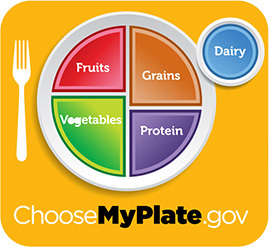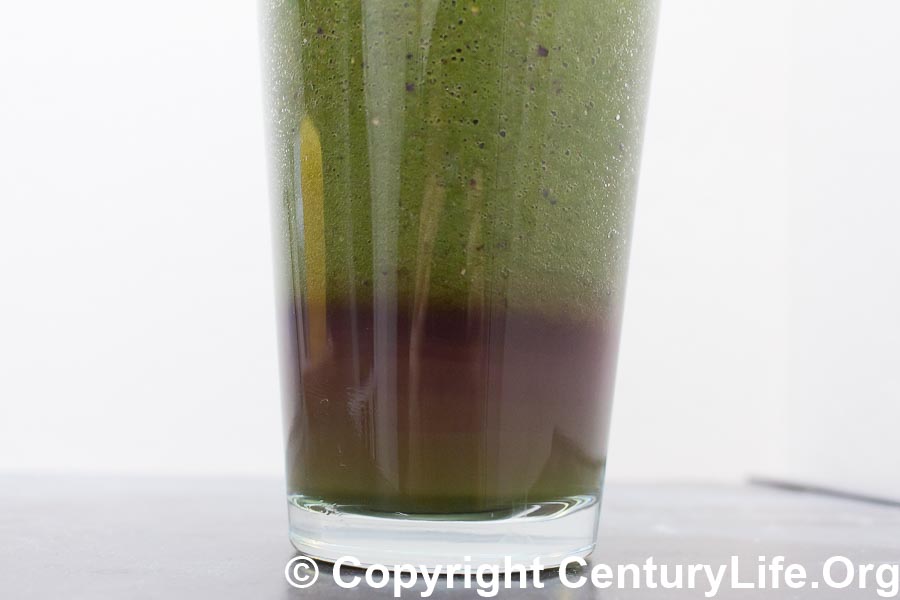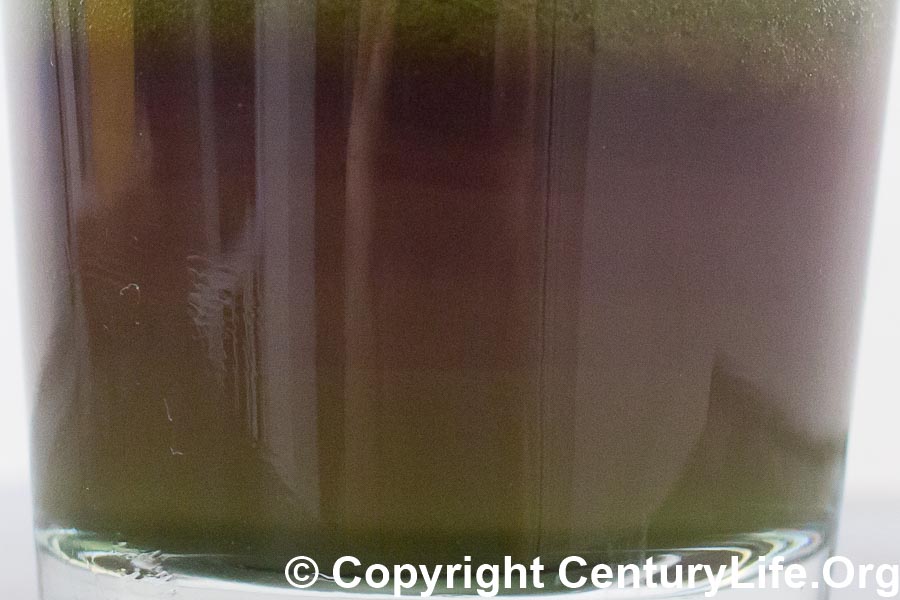How to automatically and quickly supercharge your diet every day.
Many people know that vegetables are great for their bodies, and they could afford to buy vegetables if they wanted to, but they don’t eat them anyway. Why?
Lack of time.
Think about how fast you could eat a cup of cookies. Then think about how much more time it would take you to chew through a cup of leafy greens.
Although you could cook vegetables to make them easier to chew and to digest, the act of cooking food (and cleaning up afterwards) takes time, too.
The obvious solution here is to pre-chew vegetables, and that means blending.
But blended greens taste horrible by themselves, so you’re probably going to want to add a sweetener. If you just want sweetness then honey or even plain sugar will do, but it’s better to blend fruit, because most fruits contain vitamins, minerals, and antioxidants that are good for you (think grape skins, orange pith, blueberries, etc.).
The result is a green smoothie: blended leafy greens + fruit and any other additives you want to throw in for flavor or extra nutrition. It takes as little as 90 seconds to prepare a green smoothie if you follow the directions below. However, you’re going to want a high-powered blender for green smoothies. If you try to make a green smoothie in a regular blender, you will wind up with a chewy smoothie with lots of little pieces of leafy greens and unblended seeds (if using strawberries or similar fruits). Having to chew raw greens and seeds in your smoothie isn’t pleasant and doesn’t save as much time.
BUILDING A GREEN SMOOTHIE

The U.S. federal government recommends that adults eat 5 to 6 cups of raw vegetables per day, or half that amount for cooked greens.1 In reality that should be the minimum daily intake. U.S. government guidelines are corrupted by food industry lobbyists and long-term subsidies of grain production. The food industry can make way more money on packaged grains (e.g., breakfast cereals) and meats (since many animals are fed grains) than on raw vegetables and fruits. Therefore the U.S. agricultural lobby has successfully lobbied the USDA to encourage more grain/meat consumption and less fruit/vegetable consumption.2
Not all vegetables and fruits are created equally, though.
- Among all vegetables, leafy greens, like spinach, chard, and kale, are best. They are packed with vitamins, minerals, and fiber and low in calories. In contrast, a potato is mostly starch, which gets digested into sugar. And most people don’t need more sugar in their diets.
- Fruits should be eaten along with their naturally-occurring fiber to prevent sugar spikes. Eating fruit without fiber, or drinking fruit juice alone, is almost as bad as drinking sugary soda. Your blood sugar level will rise out of control, then crash, leaving your body feeling empty. Repeatedly ingesting sugar spikes eventually leads to insulin resistance and diabetes. Fiber flattens out that sugar spike and prevents sugar crashes.3
In theory, the solution to eating more vegetables and fruits is to literally eat them whole. In practice, eating large amounts of leafy greens and whole fruits takes a lot of time and chewing. Who wants to spend hours chewing through salads (no dressing) and whole fruits (including tough and chewy fiber)?
In real life, the best way to guarantee that you get most or all of your daily intake of fruits and vegetables every day is to drink it in a smoothie. This is the process that Ann and I use every day for cheap and fast green smoothies:
- Pour 16 ounces of water into your jar. Use the 5-sided 90-ounce (Wildside) jar for Blendtecs as it gets stuck less easily than the regular four-sided jar.
- Take a bag of raw leafy greens (available at most stores; we usually use a spinach/chard/kale blend but leafy green salad mix are okay too) and
- If you’re using a Blendtec:
- Fill up the rest of the Wildside jar with the leafy greens. Take a spoon or hand and lightly pack down the leafy greens, then re-fill the jar without packing it down. Don’t pack down the leafy greens too much or the blender may get stuck blending air.
- If you’re using a Vitamix/Oster Versa 1400 and don’t want to have to use the plunger/tamper, then this is the method I use:
- Fill the 64-ounce jar with the leafy greens.
- Set the blender to manual control, lowest speed setting, and blend the 16 ounces of water with the leafy greens until it’s mostly blended together. (If necessary, put the lid on the jar and use a slightly higher speed setting. Some greens don’t blend that easily.)
- Re-fill the jar with more leafy greens, and repeat the process.
- Re-fill the jar a third time and repeat.
- If you’re using a Blendtec:
- Add about one cup of frozen fruit. We rotate through various fruit. Use more or less fruit depending on how sweet the fruit is and how sweet you like your smoothies. Usually it’s best to avoid making the smoothie too sweet, as it means you’re consuming more sugar than necessary. Fruits like berries and mangoes are sweeter than fruits like bananas.
- If you’re using a Blendtec, you may want to pulse-blend briefly at this stage.
- If you’re using a Vitamix/Oster Versa 1400 and large (more than one-inch diameter) chunks of frozen fruit, I usually manually blend the frozen fruit for several seconds to break them into smaller pieces. Doing this virtually guarantees that the blender will not get stuck blending air later.
- (OPTIONAL) Add two tablespoons of whey protein
(for some fat and protein to balance the otherwise heavily-carbohydrate smoothie; isolate is better than regular whey protein because it’s almost all protein, whereas most whey powders have large amounts of lactose and fat; you can also add a spoonful of yogurt instead of whey protein).
- (OPTIONAL) Add one tablespoon of Magnesium Powder
(health supplement; most people don’t get enough magnesium in their diets).
- (OPTIONAL) Add one tablespoon of Apple Cider Vinegar
(for taste and as a health supplement)
- Blend.
- For Blendtecs, hit the “Whole Juice” button.
- For Vitamixes/Oster Versa 1400s with a “smoothie” preset, use it. Your pre-blending ensures that the result is a very smooth smoothie–no plunger/tamper required.
- For Vitamixes/Oster Versa 1400s without presets, manually blend at low speed, then crank it up to medium and leave it there for about 40 seconds.
And that’s it. Scale it down by half if you are making green smoothie for one person. If you skip the optional extras, it’s possible to do all of this in about 90 seconds.
The above packs a huge punch: about 16 cups of raw leafy greens total, or 8 cups per person. The U.S. federal government recommends 5 to 6 cups per adult per day, so this one breakfast smoothie alone satisfies those guidelines. Plus the green smoothie has fiber from the leafy greens and fruit pulp, to prevent sugar spikes. Blending is a lot better than using a juicer, which gives you just the liquid sugar spike without the fiber.
Just remember to drink your smoothie quickly. 10 or even 20 minutes might not be enough to have the smoothie separate into solids and liquids, or to have liquids of different densities separate, but this is what green smoothie looks like after 8 hours:
MODIFICATIONS
- Fresh fruit. You can certainly use fresh fruit instead of frozen, but you gain almost no additional health benefits at a much higher cost. If you’re going to liquefy the fresh fruit anyway, why bother? Still, we do use fresh fruit occasionally, such as bananas and oranges (without the skin, but with plenty of white pith which supplies lots of nutrients and fiber). Grape, kiwi, pomegranate, and berry (e.g., strawberry, raspberry) seeds are safe to blend and can be quite nutritious. For instance, blackberry seeds contain omega-3 fatty acids, dietary fiber, and carotenoids. High-powered blenders can blend practically any whole fruit into tiny pieces, but be careful not to blend the following seeds:
- Apples, pears, stone fruits (peaches, plums, etc.) (contain precursors to cyanide; if you eat an apple seed, its tough outer coating protects your stomach from the inside of the seed, but a blender destroys the seed cover)
- Avocado pits (contains the toxic fungicide persin)
- Guava (seed disintegrates into sharp pieces)
- Technically citrus seeds (lemon, orange, etc.) contain precursors to cyanide as well, but not enough to really worry about
- When in doubt, don’t blend the seeds!
- Unpackaged greens. When we aren’t pressed for time, we also use fresh, bundled greens from the store or farmers market, but it takes extra time to unbundle and to wash them, not to mention separating out the wilted/brown leaves or snapping off particularly dirty ends of stems. You get more fiber with unbundled greens, though, since packaged greens usually have stems removed. I would encourage people to explore this option.
- Different greens.
- If you’re using stronger-tasting leafy greens like mustard greens, use less of it and fill in the remainder with a neutral-tasting leafy green like spinach, chard, or kale. And don’t ever blend spicy greens like arugula–or if you do, blend just a little bit of it, because a little goes a long way.
- Try to avoid using the same greens for weeks in a row. Either blend a mixture of greens or rotate through different greens, since each plant has a different nutrition profile.
- Frozen greens. In theory this works, but in practice there is often a poor selection of frozen greens other than frozen spinach and frozen kale. It also makes your smoothie downright icy and harder to blend. Nevertheless, we use frozen greens as a backup option in case we accidentally run out of fresh greens in the refrigerator.
- Flavorings. You can add herbs, spices, and vitamins, though I would be careful and start off slow since many herbs taste very strong when you blend them into tiny bits. For instance, a tiny bit of ginger goes a long way to giving you a flavor kick. Use an inexpensive weigh scale
for the most potent ingredients and have fun experimenting!
TIPS IF YOUR BLENDER GETS STUCK:
Sometimes your green smoothie ingredients get stuck, and the blades of the blender cut air instead of food. Here’s how to fix that:
- For Blendtecs, you want to use a 90-ounce (Wildside) jar which has a wider base than the 64-ounce jar.
- Turn the blender off.
- Pick up the jar and shake it towards and away from yourself vigorously and set it back on top of the blender. That should shake food back down into the blender blades.
- Resume blending.
- If all else fails, turn the blender off, take off the lid, and press down on the food with a spoon, then put the lid back on and resume blending.
- For Vitamixes/Oster Versa 1400s, do the same thing (shake it), or else use your tamper to press down. I only use the tamper as a last resort, since it’s one more thing to clean. Turn the blender off before using the tamper–I’ve had an incident where it was still on and sprayed green smoothie through the hole in the middle of my tamper-pressing.
TIPS FOR CLEANING YOUR BLENDER:
After green smoothies, you want to do the following to clean the jar:
- Rinse off any green smoothie from the lid and jar.
- Pour about 2 cups of hot (not boiling, just hot from the tap) water into the blender jar.
- Add a drop of dish soap.
- Place the lid on the jar and blend for several seconds on medium power.
- Remove the blender jar from the blender and rinse each piece of the blender jar thoroughly.
- You can let the blender jar dry naturally or towel it off. Try to avoid getting water underneath the jar, where the gear is.
Blender jars get cloudy with plant matter after a while; it’s an inevitable part of slamming around leaves at 240+ miles per hour. To clean that cloudiness:
- Get some powdered dishwasher detergent.
- Fill the jar with hot (not boiling, just hot from the tap) water, but not more than the recommended maximum of the blender jar. Usually filling it up 2/3 of the way or less is ok.
- Pour a half-cup of detergent into the jar.
- Place the lid on the jar and keep a hand on it just in case the lid would blow off.
- On the lowest speed setting possible, manually blend the mixture until it looks uniform (at least 30 seconds).
- Let the jar sit for at least an hour and preferably longer–even overnight.
- Empty the jar and rinse thoroughly with water. You can even blend pure water in the jar to help.
MAINTENANCE:
If it’s after a vacation or something and you haven’t used a jar in a while, rotate it from the external bottom for a few rotations to make sure it’s not stuck.
CONCLUSION
If you follow the above instructions, you will drink 100%+ of your recommended daily allowance of vegetables every day, without fail. Congratulations! You’ll never be constipated. You’ll feel more energized. No other meal delivers so much nutrition with so little preparation time. After a while, green smoothies will become automatic, because it takes so little time to make one.
Ann and I are about as lazy as they come in terms of making breakfast food, yet we have drank green smoothies for breakfast almost every day since early 2010. If we can do it, so can you! All it takes is a high-powered blender, a couple of minutes per day, and shopping for ingredients once per week.

